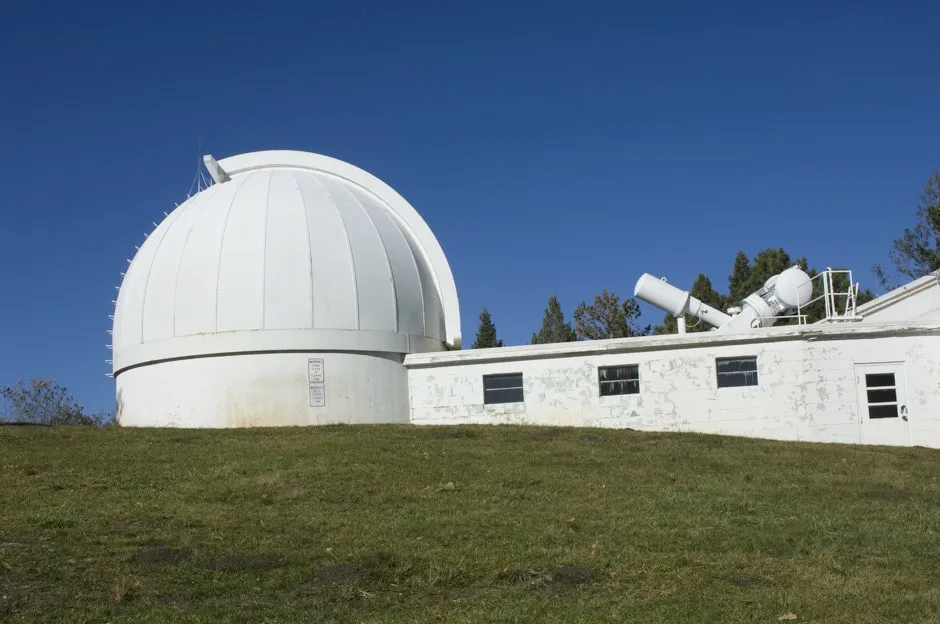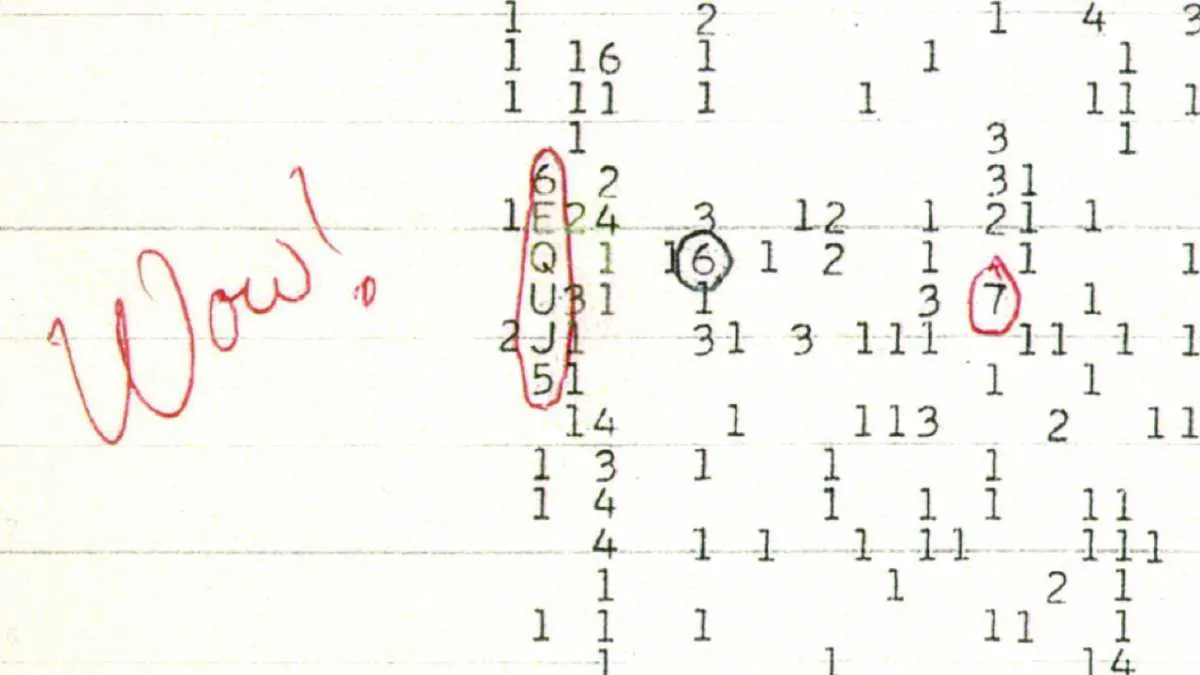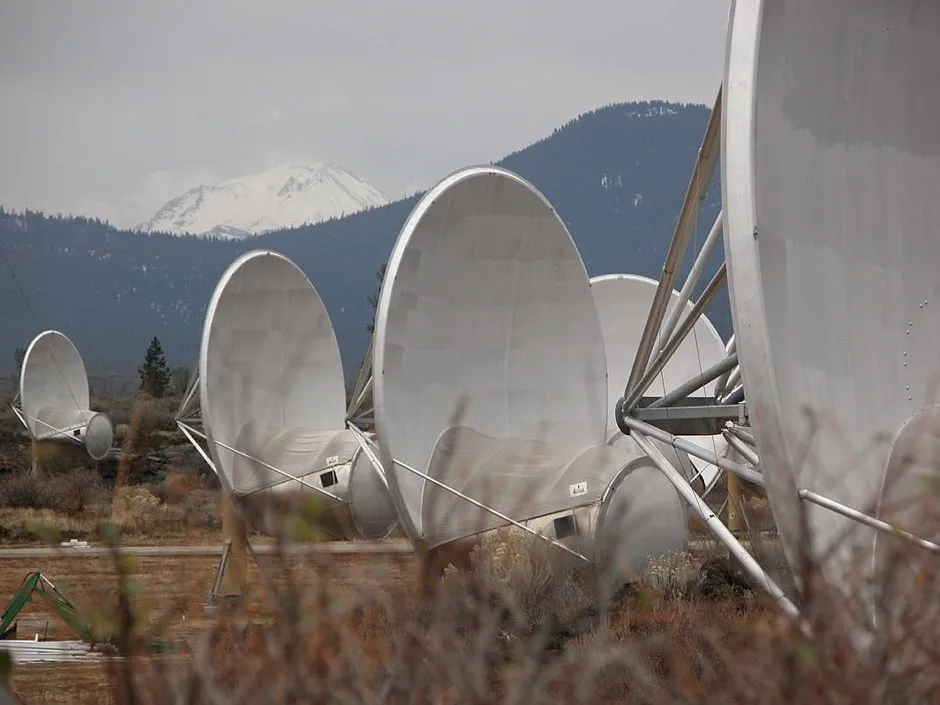Is there anybody out there? Do aliens exist? Whether the answer is yes or no, learning the truth will completely change humanity's understanding of our place in the Universe. Either we're alone, or, more remarkably, we're not.
People are drawn to conspiracy theories, so it shouldn't really be surprising that some leap on UFOs to 'prove' that alien life is here on Earth - and that it's being covered up. In this edited extract from They Are Already Here, Sarah Scoles explains why people find the idea of flying saucers so enticing.
If you wanted to watch the birth of brand-new myth about alien contact, all you needed to do was turn on the 7 September 2018 edition of KVIA nightly news.
There, anchors laid out a mystery more confusing than what city councillors in Las Cruces were doing, or what crimes had gone down in El Paso. At the desk in the studio, anchor Estela Casas furrowed her brows and squinted her eyes in suspicion as she described an evacuation in a tiny mountain town — Sunspot, New Mexico, home to a facility that studies the Sun.
“The Sunspot Observatory is empty,” Casas said. “And it’s unclear why.”
Read more about aliens:
- 10 friendly alien invasion films that will have you welcoming our bug-eyed overlords
- What would alien life actually look like?
She cut over to correspondent Mauricio Casillas, who had spent the day at the solar telescope site, about 15 miles from the small town of Cloudcroft, New Mexico — searching for answers.
Unfortunately, Casillas hadn’t found many.
“We know that the FBI is the agency that evacuated the facility,” Casillas said, “but no one seems to know what exactly is going on.”
Behind Casillas, officials had taped off the entrance to the observatory with yellow caution ribbon. No one, including the employees of the post office located inside, could enter. “Even local law enforcement doesn’t know what’s going on,” Casillas continued. “They asked us if we knew anything.”

It took national news outlets a few days to latch on to this strange story spilling out of rural New Mexico. But others were faster: Almost as soon as the local reporters like KVIA’s spoke about the situation, Conspiracy Internet was on it.
And of course Conspiracy Internet was on it. The FBI... in a telescope town... with an evacuation order: It’s like an end-of-the-world Clue [Cluedo] game.
The day after KVIA’s broadcast, a user called SeaWorthy started a Sunspot thread on a conspiracy forum called Above Top Secret. Many parts of this forum are — like most conspiracy websites — full of hate and fear and bad information.
But among those baddies and bigots, there are also smart digital denizens. Even if their favoured topics are Out There, they keep investigating genuine mysteries long after the general public has let them disappear, like whack-a-moles, from with the news cycle.
Read more about conspiracy theories:
“Easy to make myself a disaster movie scenario from the Post office being closed too,” SeaWorthy wrote. “…If it were a movie the FBI would soon come up with a cover story to put out.”
A user called DBCowboy chimed in: “In ‘Close Encounters’ they staged a mock chemical spill and evacuated a town.”
“How far is it from Roswell?” someone joked.
In the r/Conspiracy forum on the discussion site reddit, users also quickly chimed in with cosmic options: Maybe the telescopes atop Sacramento Peak had seen a solar flare that would kill us all. “I hope it’s friendly aliens with cool drugs and not a rain of asteroids,” said cosmicmailman.
Occasional jests like these suggested aliens or UFOs or alien UFOs.
But mostly, conspiratorial types stuck to earthly or cosmically nonbiological suggestions for the FBI presence and population evacuation: a leak from the ten tons of mercury on which one astronomical instrument floats; a spy peering down on nearby White Sands Missile Range, the largest military facility in the US; a threat of arson; installation of secret equipment; biohazards sent via post.
Regardless, though, of whether conspiracies are of the celestial or terrestrial type, they sprout from the same root: They represent secrets the powerful know that you don’t. In that way, it’s always aliens, even when it’s not.
Despite the largely just-a-joke nature of the actual conspiracists’ alien mentions, when the story got national, mainstream coverage, ET dominated the headlines.
Read more about the hunt for alien life:
- How synthetic atmospheres could help us hunt for alien life
- First contact: what if we find alien life?
“Mysterious Observatory Evacuation Stirs Alien Conspiracy Theories,” “Sheriff Describes Mysterious FBI Tests amid Alien Speculation,” “Alien Conspiracy Theories Swirl after FBI Evacuates Space Observatory.”
Given the clamour of the rumours, or — more accurately, the clamour about the clamour of rumours — an observatory spokesperson even felt compelled to say, “I can tell you it definitely wasn’t aliens.” She would say nothing else substantial.
The alien theory seemed almost to have come from the headlines themselves, which first presented and then refuted it. Clickbait fodder surely played into this.
But on a deeper level, headlines are designed to tap into what human readers most want, fear, and expect. “It’s aliens, they’re here” represents all of the above.
Sunspot’s saga is the stuff of feature films. Films in which the world falls apart or we save ourselves or both. Films in which our lives become more exciting or terrible or both.

This is it! we allow ourselves to think, reading about the tightlipped closure of a telescope town — the town that saw too much. This is how it begins.
“It” represents the exciting, terrible future, full of salvation and destruction, that we’ve been told — by religious leaders and movies — is ours to inherit.
The night of 12 September, I arrived home in Denver — about nine hours from Sunspot — and siphoned up the stories that I’d missed while away on a trip.
It’s so close, I thought. I could just go see. Because it was a federal observatory, I knew Sunspot was likely located on federal land — so even if the observatory itself was blocked off, I could probably camp pretty close, and maybe hike closer, without breaking the blockade.
Read more about conspiracies:
- Why you can't argue with a conspiracy theorist
- Why COVID-19 is a breeding ground for conspiracy theories
By noon, I had stuffed my backpack and mapped out a base camp for myself, as well as a route to the far side of the observatory. I would try to talk to some townsfolk. I would have polite conversations with FBI agents.
I would see whether alien seekers had descended on this small, solar-centric place. I would find out the answers, which I wanted as much as any Above Top Secret detective (by this point, the pages of discussion ran into the dozens).
Driving deep down Colorado and New Mexico’s empty highways, I finally arrived in the outdoor-retail-centric town of Cloudcroft, the last outpost before Sunspot. I stopped at the local gas station for firewood. And after I paid, as I was walking out the door, the clerk called to me.
“Watch out for deer and elk,” he said. “If it’s dark out there, it’s dangerous.”

The words felt ominous. And it was dark. By the time I got to a trailhead called Cathey Vista, the air was black in the way it can only be in rural places: like light has never shone here and may never again. Like just beyond the beam of your head lamp is a monster. An alien, a mothership, Bigfoot, a serial killer.
When knowledge hides beyond our senses, we tend to imagine the worst or most powerful or both. Especially, perhaps, when we are camping near a place that has been evacuated for unknown reasons.
I set my spot up a few yards down the trail, squinting to see behind every tree. Hearing aircraft and wondering if they could see me. Listening to the bugle calls of mating elk which sound like autotuned cries from cryptozoological creatures — and feeling like they would soon be, if they were not already, upon me.
Observatories are a natural place for conspiracies and coverups to roost, whether they be of the alien sort or not. These ideas, after all, spring from a general distrust of authority, from a sense that officials are hiding information, and from the historical truth that, yeah, the people with power wheel secret dealings and bury information that should be public.
Read more about UFOs:
- UFO sightings: the science
- Is a mysterious pink UFO watching the International Space Station?
- ‘Alien warship’ UFO seen firing lasers at Earth… apparently
Sometimes those powerful people are FBI agents. Sometimes they are scientists. Sunspot provided the perfect overlap. Here, a special group collects data on the cosmos, in a way inaccessible to the average person, and now the feds had descended and weren’t talking.
Were they hiding evidence of aliens or their craft? That’s a slightly ridiculous notion, but the way astronomers tend to treat ufological claims doesn’t help dispel them — here or in general.
Scientists often dismiss UFO sightings and the idea that aliens are already here. Dealing with these claims is not worth their time — because the evidence isn’t solid enough.
If they don’t dismiss, they frequently debunk — because the evidence is only worth knocking down, without any validation or acknowledgement of a person’s feelings and experiences.
Studies of how scientists and communicators deal with climate change deniers and antivaccination activists show that such debunking isn’t very effective, that implying believers are dumb and providing piles of evidence don’t usually change minds. The tactics come off as both condescending and as protesting too much — the data-centric version of “nothing to see here.”
Communications professor Adam Dodd, from the University of Queensland, has said that astronomers’ public declarations about UFOs are “performative.”
They treat the topic the way Science expects them to, so that the community continues to accept them. Their words bolster the existing boundaries of science, keeping them inside and UFOs out, banging on the border wall.
In reality, Dodd contended, their statements actually represent “a departure from the principles of sagacity, objectivity, and curiosity that are usually seen as characterising their profession.”
Read more about conspiracy theories:
- If a long history of unconscious bias can teach us anything, it's that faulty thinking can be fatal
- How to argue with a Moon landing denier
For example, he points to a time when famed physicist Stephen Hawking committed a logical fallacy he would have found unpalatable elsewhere: citing the absence of evidence (“I’ve never seen a credible UFO or Earth-dwelling alien report”) for evidence of absence (“Therefore they cannot be here”).
On top of that, Dodd continued, citing psychologist Stuart Appelle, ufology “is not simply rejected as a legitimate discipline, it is categorically dismissed.”
Those are not the same action: “Rejection suggests a conclusion based on close examination and careful reflection. Dismissal is an a priori judgment that close examination is not warranted.”

If anyone has ever dismissed you, you know how it makes you feel: First, bad about yourself. Then, you feel that, no, they are the ones who are wrong, and you’d like to prove it. And finally, if you’re a bit paranoid, like they know they’re wrong and have an interest in hiding the truth.
With this mutual antagonism in place, the sites where scientists construct cosmic knowledge — telescopes — provide fertile ground for conspiracies, celestial or otherwise.
Add in some FBI agents, an apparent gag order, and a few displaced residents, and you’ve got yourself the perfect environment for imagination to evolve its own story.
They Are Already Here:UFO Culture and Why We See Saucers by Sarah Coles is out now (£20, Pegasus).
- Buy now from Wordery, Waterstones and Amazon UK